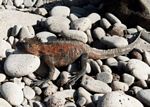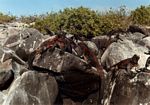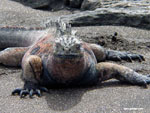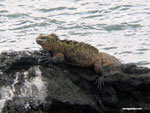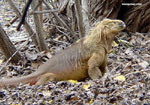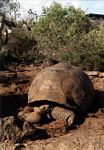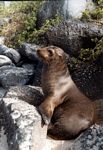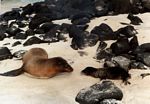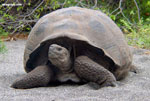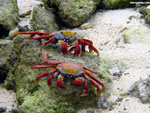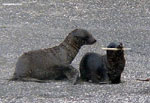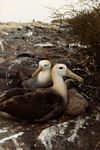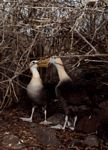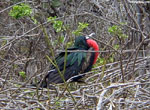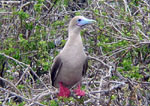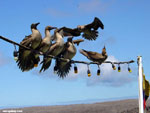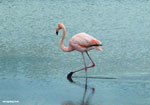
|
ECUADOR |
|
Galapagos Islands, Ecuador travel pictures
All images are the property of mongabay.com.
Contact me regarding use and reproduction.
Rainforest report for Ecuador - from the late 1990s Library of Congress: Ecuador Recommended travel guides on Ecuador Recommended travel guides on the Galapagos Islands: 
News on Galapagos The Galápagos Islands are an archipelago of some 13 volcanic islands and associated islets and rocks located in the Pacific Ocean about 1,000 kilometers west of the coast of South America. The Galápagos archipelago is politically part of Ecuador. The oldest of the islands are about 4 million years old and the youngest are still in the process of being formed. Indeed, the Galápagos islands are considered to be one of the most active volcanic areas in the world. They are famed for their vast number of endemic species and the studies conducted by Charles Darwin that led to his theory of natural selection. The islands are distributed to the north and south of the equator. The equator crosses the northern part of the largest island, Isabela. Conservation Though the first protective legislation for the Galápagos was enacted in 1934 and supplemented in 1936, it was not until the late 1950s that positive action was taken to control what was happening to the native flora and fauna. In 1955, the International Union for the Conservation of Nature organized a fact-finding mission to the Galápagos. Two years later, in 1957, UNESCO in cooperation with the Government of Ecuador sent another expedition to study the conservation situation and to choose a site for a research station. In 1959, the centenary year of Darwin's publication of The Origin of Species, the Ecuadorean government declared 97.5% of the archipelago's land area, except áreas already colonized, as a national park. In the same year, the Charles Darwin Foundation was founded, with its international headquarters in Brussels. Its primary objectives were to ensure the conservation of unique Galápagos ecosystems and promote the scientific studies necessary to fulfill its conservation functions. With the establishment of the Charles Darwin Research Station in 1964, conservation work began. During the early years, conservation programs, such as eradication of introduced species and protection of native species, were carried out by Station personnel. Currently, most resident scientists pursue conservation goals; most visiting scientists' work is oriented towards pure research. When the national park was established, approximately 1,000 to 2,000 people called the islands their home. In 1972 a census was done in the archipelago and a population of 3,488 was recorded. By the 1980s, this number had dramatically risen to more than 15,000 people. In 1986 the surrounding ocean was declared a marine reserve. UNESCO recognized the islands as a World Heritage Site in 1978, which was extended in December 2001 to include the marine reserve. Noteworthy species include:
Introduced plants and animals, which have been brought accidentally or willingly to the islands by humans, represent the main threat to Galápagos. They become plagues that affect the balance of the ecosystem of Galápagos due to the lack of natural enemies that result in their fast propagation. Some of the most harmful introduced plants are the Guayaba or Guaba Psidium guajava, avocado Persea americana, cascarilla Chinchona sucsirubra, balsa Ochroma pyramidale, blackberry Rubus glaucus, various citrus (orange, grapefruit, lemon), floripondio Datura arborea, higuerilla Ricinus communis and the elephant grass Pennisetum purpureum. These plants have invaded large areas and eliminated the endemic species in the humid zones of San Cristobal, Floreana, Isabela and Santa Cruz. A long list of introduced animals were brought to Galápagos mainly by pirates and buccaneers. Heyerdal quotes documents that mention that the Viceroy of Peru, knowing that British pirates ate the goats that they themselves had released in the islands, ordered dogs to be freed there to eliminate the goats. Also, when colonization of Floreana by Jos� de Villamil failed, he ordered that the goats, donkeys, cows, and other animals from the farms in Floreana be transfered to other islands for the purpose of later colonization. Non-native goats, pigs, dogs, rats, cats, mice, sheep, horses, donkeys, cows, poultry, ants, cockroaches, and some parasites inhabit the islands today. Dogs and cats attack the tame birds and destroy nests of birds, land tortoises, and marine turtles. They sometimes kill small galapagos tortoises and iguanas. Pigs are even more harmful, covering larger areas and destroying the nests of tortoises, iguanas, and marine turtles. Pigs also knock down vegetation in their search for roots and insects. This problem abounds in Cerro Azul volcano and Isabela, and in Santiago pigs may be the cause of the disappearance of the land iguanas that were so abundant when Darwin visited. The black rat Rattus rattus attacks small galapagos tortoises when they leave the nest, so that in Pinz�n they stopped the reproduction for a period of more than 50 years; only adults were found on that island. Also, where the black rat is found, the endemic rat has disappeared. Cows and donkeys eat all the available vegetation and compete with native species for the scarse water available. In 1959, fishermen introduced one male and two female goats to Pinta island; by 1973 the National Park service estimated the population of goats to be over 30,000 individuals. Goats were also introduced to Marchena in 1967 and to Rabida in 1971. 
Main Islands The archipelago has been known by many different names, including the "Enchanted Islands" because of the way in which the strong and swift currents made navigation difficult. The first crude navigation chart of the islands was done by the buccaneer Ambrose Cowley in 1684, and in those charts he named the islands after some of his fellow pirates or after the English noblemen who helped the pirates' cause. The main islands of the archipelago (with their English names) are
The Galápagos were discovered by chance in March 10, 1535 when Dominican Fray Tomás de Berlanga, the Bishop of Panama, sailed to Peru to settle a dispute between Francisco Pizarro and his lieutenants after the conquest of the Incas, while performing an administrative mission for the Spanish Monarch Carlos V. The bishop's ship stalled when the winds died and strong currents carried him out to the Galápagos. In his account of the adventure, addressed to Emperor Carlos V, Berlanga described the harsh, desert-like condition of the islands and their trademark giant tortoises. He wrote about the marine iguanas, the sea lions and the many types of birds. He also noted the remarkable tameness of the animals that continues to thrill and delight modern visitors. The islands are believed to date back to six million years ago as a result of volcanic activity generated beneath the ocean's floor. They were uninhabited, although Thor Heyerdahl in 1963 reported findings of pottery of South American origin that suggested earlier contacts, a theory that appears to still be controversial. The archipelago was used as hiding place by the English pirates that pilfered the Spanish galleons carrying gold and silver from South America to Spain. The islands first appeared on maps in about 1570 in those drawn by Abraham Ortelius and Mercator. The islands were called "Insulae de los Galopegos" (Islands of the Tortoises). The first Englishman to visit Galápagos was Richard Hawkins, in 1593. From that time until 1816 many famous pirates visited the archipelago. Alexander Selkirk, the man whose adventures in Juan Fernández Islands inspired Daniel Defoe to write Robinson Crusoe, visited the Galápagos in 1708 after he was picked up from Juan Fernández by the privateer Woodes Rogers. Rogers was refitting his ships in the islands after sacking Guayaquil. The first scientific mission to the Galápagos arrived in 1790 under the leadership of Alessandro Malaspina, a Sicilian captain whose expedition was sponsored by the King of Spain. However, the records of the expedition were lost. In 1793, James Collnet made a description of the flora and fauna of Galápagos and suggested that the islands could be used as base for the whalers operating in the Pacific Ocean. He also draw the first accurate navigation charts of the islands. Whalers killed and captured thousands of the Galápagos tortoises to extract their fat. The tortoises could also be kept on board ship as a means of providing of fresh protein as these animals could survive for several months on board without any food or water. The hunting of the tortoises was responsible for greatly diminishing and in some cases eliminating certain races. Along with whalers came the fur-seal hunters who brought the population of this animal close to extinction. Ecuador annexed the Galápagos Islands on February 12, 1832, naming it Archipelago of Ecuador. This was a new name that added to several names that had been, and are still, used to refer to the archipelago. The first governor of Galápagos, General Jos� de Villamil, brought a group of convicts to populate the island of Floreana and in October 1832 some artisans and farmers joined. The Voyage of the Beagle brought the survey ship HMS Beagle under captain Robert FitzRoy to the Galápagos on September 15, 1835 to survey approaches to harbors. The captain and others on board including his companion the young naturalist Charles Darwin made a scientific study of geology and biology on four of the thirteen islands before they left on October 20 to continue on their round-the-world expedition. The governor of the prison colony on Charles Island told Darwin that tortoises differed from island to island, and when specimens of birds were analysed on return to England it was found that many different kinds of birds were species of finches which were also unique to islands. These facts were crucial in Darwin's development of his evolution theory, which was presented in The Origin of Species. Jos� Valdizán and Manuel Julián Cobos tried a new colonization, beginning the exploitation of a type of lichen found in the islands (Roccella portentosa) used as a coloring agent. After the assassination of Valdizán by some of his workers, Cobos brought from the continent a group of more than a hundred workers to San Crist�bal island and tried his luck at planting sugar cane. He ruled in his plantation with an iron hand which lead to his assassination in 1904. Since 1897 Antonio Gil began another plantations in Isabela island. Over the course of a whole year, from September 1904, an expedition of the Academy of Sciences of California, led by Rollo Beck, stayed in the Galápagos collecting scientific material on geology, entomology, ornithology, botany, zoology and herpetology. Another expedition from the same Academy was done in 1932 (Templeton Crocker Expedition) to collect insects, fish, shells, fossils, birds and plants. During WWII Ecuador authorized the United States to establish a naval base in Baltra island and radar stations in other strategic locations. In 1946 a penal colony was established in Isabela Island, but was suspended in 1959. UNESCO declared the Galápagos Islands Humanity Natural Heritage in 1979 and, six years later, a Biosphere Reserve (1985), which has resulted in an even greater interest at the international level. TRAVEL [Wikitravel] The Galápagos archipelago is world-renowned for its unique and fearless wildlife - much of which was inspiration for Charles Darwin's Theory of Natural Selection. The islands are therefore very popular amongst natural historians, both professional and amateur. Giant tortoises, sea lions, penguins, marine iguanas and different bird species can all be seen and approached. The landscape of the islands is relatively barren and volcanic, but beautiful nonetheless. The highest mountain amongst the islands is Volcán Wolf on Isla Isabela, 1707 m (5600ft) high. The Galápagos were claimed by newly-independent Ecuador in 1832, a mere three years before Darwin's visit on the Beagle. During the 19th and early 20th centuries the islands were inhabited by very few settlers and were used as a penal colony, the last closing in 1959 when the islands were declared a national park. The Galapagos were subsequently listed as a World Heritage Site in 1978. Strict controls on tourist access are maintained in an effort to protect the natural habitats and all visitors must be accompanied by a national park-certified naturalist tour guide. The islands currently receive an average of 60,000 visitors per year. Boat tours Seeing the sites and wildlife of the Galapagos is best done by boat. Most people book their place well in advance (as the boats are usually full during the high season). Booking a boat tour with a company in your home country will usually be the most convenient, but is often considerably more expensive. Boat tours can also be arranged from Guayaquil, Quito, and even from Puerto Ayora. While it is possible to get a last-minute deal, be aware that many budget tours may spend extra time in Puerto Ayora, might not always be on the best boats, and may only visit the inner islands. In either case, when looking for a tour consider the following:
On each island, the number of visitors of limited and the are only a small number of official landing and visitor sites. You must follow the instructions of your guide to protect the wildlife and you are not allowed off the marked paths. This is not a problem as the animals are so tame they will sit right on the path or cross it without caring about mere tourists. Do Recommended activities:
Sleep There are hotels and other accommodation in the towns of Puerto Ayora and Puerto Baquerizo Moreno, however if you really want to see lots of good wildlife, you are best taking at least a 3 day boat tour (see Boat tours above). Stay safe In general crime is not a problem in the Galapagos. Petty crime may occur in the towns, and occasionally fisherman will stage strikes or demonstrations that affect tourists, but for the most part there is little to be concerned about. The animal life in the islands is mostly docile with the exception of the large bull sea lions. These animals will vigorously protect their harems, and can inflict dangerous and potentially deadly bites. Do not snorkel close to sea lion colonies. If a bull sea lion approaches you, swim away from the nearest colony. Note that it is only the bulls that are dangerous; swimming with juvenile sea lions can be one of the most exciting parts of a trip. In addition to sea lions, there is a minimal danger from sharks. In general sharks will not attack unless provoked, although attacks can sometimes occur in murky water when sharks mistake humans for other animals. However, by exercising simple common sense experiences will be almost always be positive. Respect The park is strictly regulated. Outside of the towns visitors must be accompanied by guides, and visitors are only allowed on land from sunrise until sunset. Itineraries must be registered with the park prior to embarking on a trip, and animals should never be disturbed; while the wildlife in the Galapagos will usually ignore your presence, a general rule of thumb is that if an animal notices your presence then you are too close. Two meters is generally given as a minimum distance to keep away from animals; you will find that if you are calm and respectful that many animals will walk right up to investigate you. One of the greatest dangers to the islands is introduced species. The park service is trying to eliminate goats, rats, cats, dogs, and introduced plant species on many of the islands, but it is a difficult battle; after evolving for thousands of years without predators, the Galapagos wildlife is not adapted to handle these new species. When traveling to the islands, do not bring any plant or animal life with you, and be sure to always clean your footwear when traveling between islands to avoid accidentally transferring seeds. The codified park rules are:
Articles involving tourism in Ecuador: |
what's new | rainforests | tropical fish | for kids | search | about | copyright & use | contact |
Copyright Rhett Butler 1994-2012 Pictures were taken by Rhett A. Butler, copyright 2008. While these photos are the property of mongabay.com, it may be permissible to use them for non-commercial purposes (like powerpoint presentations and school projects), provided that the images are not altered in any form. Please read this for more details. If you are interested in using an image in a publication please contact me. Mongabay.com is a free resource. |

